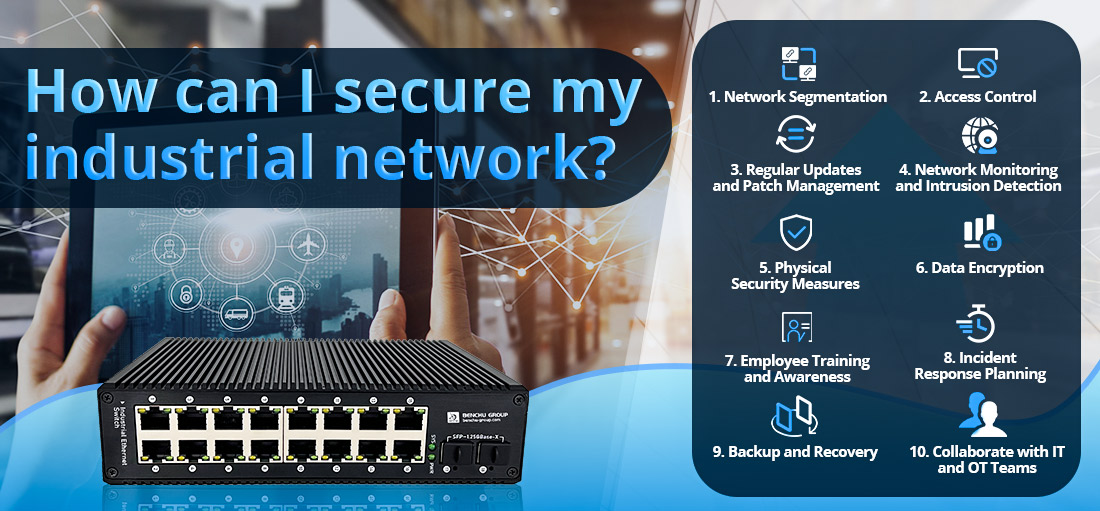
Securing an industrial network is crucial to protecting sensitive data, maintaining operational integrity, and preventing unauthorized access or attacks. Given the unique challenges faced in industrial environments, a multi-layered security approach is necessary. Here’s a detailed description of key strategies for securing your industrial network:
1. Network Segmentation
a. Create VLANs
--- Virtual LANs (VLANs) can be used to segment different parts of the network, isolating critical systems (like SCADA) from less secure areas (like office networks). This limits the spread of potential breaches and minimizes exposure to vulnerabilities.
b. Use Firewalls
--- Implement Firewalls between segments to control traffic flow and enforce security policies. Firewalls can prevent unauthorized access and filter out malicious traffic.
2. Access Control
a. Implement Role-Based Access Control (RBAC)
--- Define User Roles: Assign permissions based on user roles to ensure that only authorized personnel have access to critical systems and sensitive data. Limit privileges to the minimum necessary for each role.
b. Use Strong Authentication
Multi-Factor Authentication (MFA): Implement MFA to require additional verification for accessing sensitive systems, reducing the risk of unauthorized access due to stolen credentials.
3. Regular Updates and Patch Management
a. Keep Systems Updated
--- Regularly Update Software: Ensure that all industrial control systems (ICS), operating systems, and applications are up-to-date with the latest security patches. This helps close vulnerabilities that could be exploited by attackers.
b. Manage Firmware Updates
--- Device Firmware: Regularly check for and apply firmware updates for network devices, including industrial switches, routers, and IoT devices, to protect against known vulnerabilities.
4. Network Monitoring and Intrusion Detection
a. Implement Security Information and Event Management (SIEM)
--- Real-Time Monitoring: Use SIEM tools to monitor network traffic and analyze logs for unusual activity. This allows for rapid detection and response to potential security incidents.
b. Intrusion Detection Systems (IDS)
--- Deploy IDS to identify and alert on suspicious activities or breaches. Anomaly detection systems can help identify deviations from normal behavior, indicating potential attacks.
5. Physical Security Measures
a. Secure Physical Access
--- Access Controls: Restrict physical access to network devices and control systems to authorized personnel only. Use keycards, biometrics, or security guards to enforce this.
b. Environmental Controls
--- Protect Against Environmental Threats: Ensure that network equipment is protected from environmental hazards, such as fire, flooding, and unauthorized physical access.
6. Data Encryption
a. Encrypt Data at Rest and in Transit
--- Data Protection: Use encryption protocols (e.g., TLS, IPsec) to protect data being transmitted across the network and to secure stored data. This ensures that sensitive information remains confidential, even if intercepted.
b. Secure Communication Channels
--- VPNs: Implement Virtual Private Networks (VPNs) for remote access to ensure that data transmitted over public networks is encrypted and secure.
7. Employee Training and Awareness
a. Conduct Regular Training
--- Security Awareness Training: Provide ongoing training for employees on cybersecurity best practices, such as recognizing phishing attempts, safe internet browsing, and proper handling of sensitive information.
b. Simulate Attacks
--- Red Team Exercises: Conduct simulated attacks (e.g., phishing campaigns, penetration testing) to assess employee readiness and reinforce training.
8. Incident Response Planning
a. Develop an Incident Response Plan
--- Prepare for Breaches: Create a comprehensive incident response plan that outlines steps to take in the event of a security breach, including roles, responsibilities, and communication protocols.
b. Regularly Test the Plan
--- Drills and Exercises: Conduct regular drills to test the incident response plan, ensuring that all personnel know their roles and that the plan is effective.
9. Backup and Recovery
a. Regular Data Backups
--- Backup Critical Data: Implement a regular backup strategy to ensure that critical data and configurations are saved. Store backups securely and consider off-site or cloud storage for redundancy.
b. Test Recovery Procedures
--- Ensure Restore Capabilities: Regularly test backup and recovery procedures to ensure data can be restored quickly in the event of a cyber incident or data loss.
10. Collaborate with IT and OT Teams
a. Foster Communication
--- Integrate IT and OT Security: Ensure collaboration between IT (Information Technology) and OT (Operational Technology) teams to develop unified security policies that address both environments.
b. Adopt a Holistic Approach
--- Unified Security Strategy: Develop a comprehensive security strategy that encompasses both IT and OT, recognizing the unique challenges and requirements of each.
Conclusion
Securing an industrial network requires a comprehensive, multi-layered approach that addresses both technological and human factors. By implementing strategies such as network segmentation, access control, regular updates, monitoring, and employee training, organizations can significantly reduce their vulnerability to cyber threats. Proactive measures, along with an effective incident response plan, are essential to safeguarding critical infrastructure and ensuring operational integrity in an increasingly connected industrial environment.